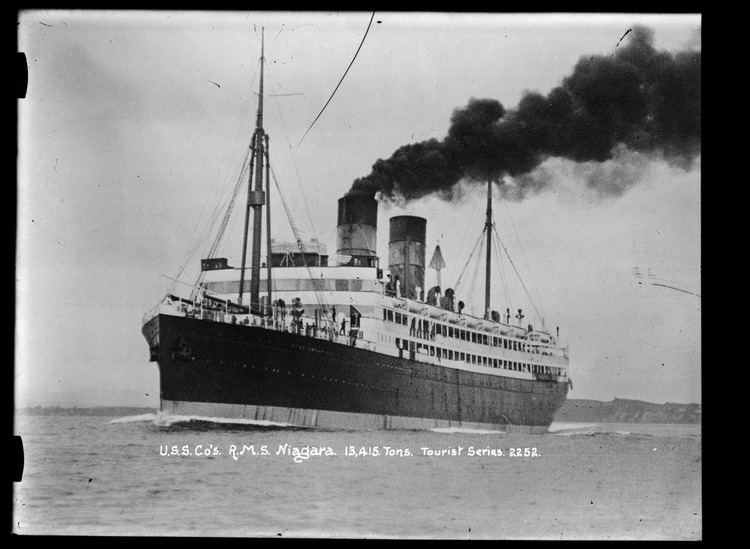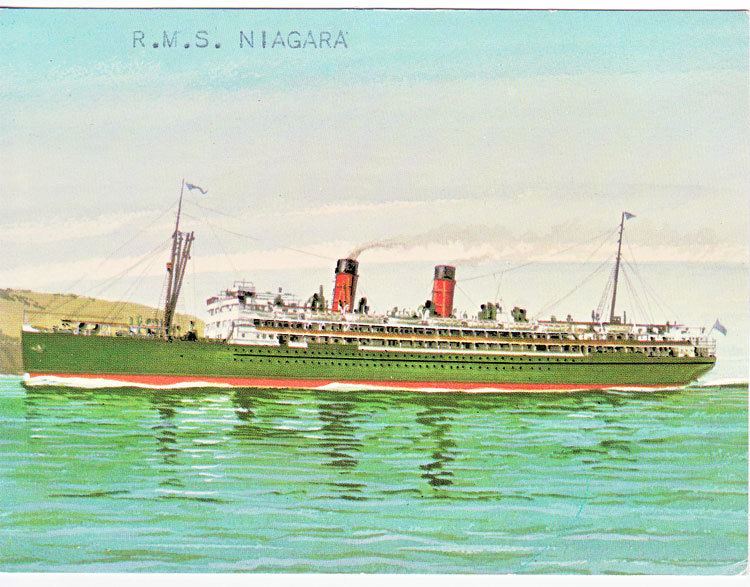Name RMS Niagara Tonnage 13,415 GRT Length 160 m Draft 8.56 m Builder John Brown & Company | Completed March 1913 Launched 17 August 1912 Depth 11 m Beam 20 m | |
 | ||
Draught 28 feet 1 inch (8.56 m) Propulsion Two triple-expansion engines; one low-pressure turbine; three screws | ||
RMS Niagara was an ocean liner launched on 17 August 1912 and owned by the Union Steam Ship Company intended for the Australia-Vancouver, Canada service. She was nicknamed "the Titanic of the Pacific", but after the sinking of the real RMS Titanic this was dropped in favour of "Queen of the Pacific". She should not be confused with an earlier RMS Niagara, an ocean liner built in 1848 for the Cunard Line.

At the start of World War II, RMS Niagara was operated by the Canadian-Australasian Line, maintaining a service from Auckland, New Zealand, to Suva and Vancouver.

On 19 June 1940 she was under the command of Captain William Martin and had just left Auckland when, off Bream Head, Whangarei, she struck a mine laid by the German auxiliary cruiser Orion and sank in 121 metres of water. No lives were lost.

A secret and large consignment of gold from the Bank of England was in Niagara's strong room and went down with the ship. The gold was payment from the UK to the USA, which had not yet entered the war, for munitions supplies.

Gold salvage

A Melbourne company, United Propriety Salvage Ltd, was promptly contracted to recover the gold. At the time it was one of the deepest salvage operations ever undertaken. The salvage team was led by Captain J. P. Williams and John Edwards Johnstone on the ship Claymore.

The Claymore, built in 1902, 260 tons gross, was an old coastal steamship. When first sighted for the salvage job she was a hulk rusting on the banks of Auckland Harbour. Before recovering any gold the Claymore had to be salvaged herself.
Once Claymore had been restored to working order, the salvage team based themselves out of Whangarei and began operations on 15 December 1940. It took Claymore about two months to find the wreck, which it did by dragging its anchor along the seabed, and minefield. Twice during the search she fouled unexploded mines and was nearly sunk.
On 2 February 1941 the wreck of the Niagara was found and the salvage team started the arduous and hazardous task of retrieving the gold for HM Treasury. They had only rudimentary equipment, a viewing/diving chamber, radio, and a grab lowered from the surface.
Williams and his team blasted a hole in Niagara's hull and successfully recovered 555 gold bars: more than eight tonnes. They followed in 1953 by a further 30 gold bars, leaving five bars still unrecovered in the wreck as of 2011.
The diving chamber used in the salvage still exists, on display at the Castlemaine Museum in the town of Castlemaine, Victoria, where it had been made by Thompson's Foundry in late 1940.
